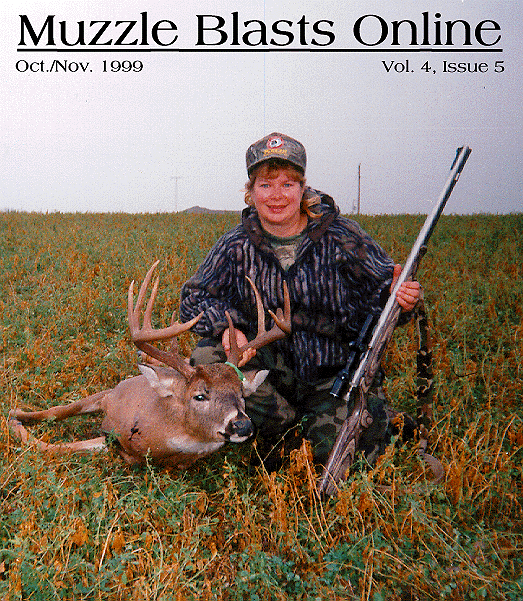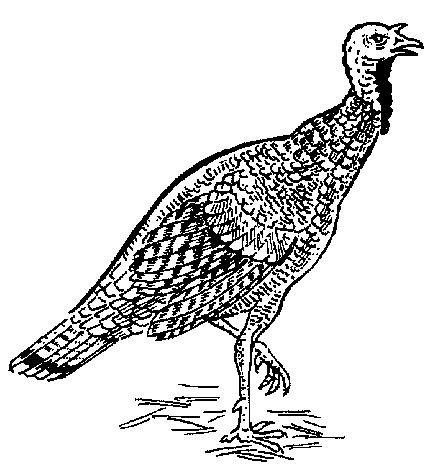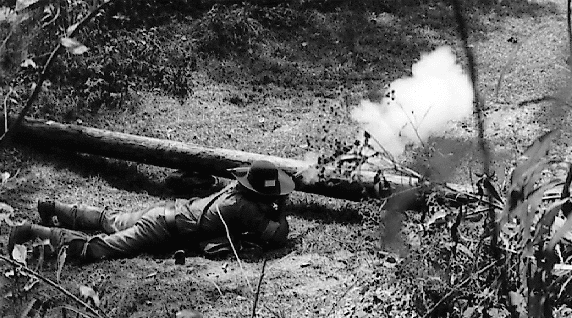|
Muzzle Blasts Online |
|
...for the muzzleloading enthusiast |
|
The muzzleblasts.com domain, subdomains, content, etc., are neither affiliated with the NMLRA nor its paper magazine Muzzle Blasts |
|
Muzzle Blasts Online |

|
|
|
|
|
|
A Rifleman's Turkey Shoot

|
Now, far be it from me to ever disagree with anyone's way of doing things; I'm all for cultural diversity. But that shooting-cards-with-a-shotgun thing makes about as much sense to me as trying to herd cats. Out here, on the sunset-side of the Rockies, in the Real West, a turkey shoot is still done with rifles, the old-fashioned way....sorta.
In fact, there are a number of ways that one can put on a real, honest-to-goodness turkey shoot and still not get the SPCA down on your neck. Such shoots are lots of fun and a dandy way for a club to earn money for charity and such expenses as range improvements, insurance, and so forth.
The first thing a shoot "booshway" needs to do is appoint a shoot "segundo." Once you have that done, the rest is a cinch. The segundo has to take care of it. This is known as delegating authority (It's also called "passing the buck.") Your segundo goes to the local supermarket and talks to the manager. If he informs the manager that you are a non-profit, black powder shooting club, putting on a turkey shoot to earn money for charity and expenses, he will probably give you a goodly discount on nice plucked, gutted, pre-basted, tender-timed, frozen birds. Better yet, buy the birds right before Thanksgiving when they are on a loss-leader sale. These birds may not be totally authentic, but the contestants will be tickled silly to learn that they don't have to draw and de-feather their prizes. Been there, done that. It's a pain in the nether regions!
Now the booshway (or the segundo, if you wish to pass more buck,) has to decide just what events he wants to have in his turkey shoot. This decision is often based upon how many shooters you expect, the amount of time you want to dedicate to the shoot, and the space you have to work with. Let me describe a number of possible events, and you can decide which ones fit your needs.
First off, there is the traditional turkeys-behind-a-log, shoot-em-in-the-head event. For this you need a log, a flat board and a bunch of old bowling pins. (These are usually available from a local bowling alley for a very nominal sum.) The log is placed at a ninety- degree angle to the shooters and right up against a backstop so that any ricochets off of the log will go into the backstop and not over it. The flat board is placed behind the log as a base for the bowling pins to stand on. If more than about three to four inches of the pins protrudes above the log, place scrap pieces under the log to raise it. Now it is time to start shooting.

|
|
Another variation on this type of event is to do your shooting over a log, just as the old-timers did. |
If there are quite a few shooters, it is a good idea to have numbers in front of the "turkeys" and at the shooting points to prevent cross-firing. The shooters line up at 35 to 50 yards (depending upon the average ability of your club's members) and shoot off-hand at the "heads." Those who miss are out. You can, if you wish, make a rule that if you clip the log the shot counts as a miss, even if a bird does fall. Next, the ones who hit move back 5 to 10 paces and shoot again. (If need be, while the shooters are moving, turkey-setters can be replacing any knocked-over "birds". Of course, nobody re-loads until the setters are behind the firing line once more.)
Now the shooting, replacing of birds, and moving back continues until you have your top three shooters. (Or however many birds you are giving out on this event.) I have seen matches where the top three are sorted out by the time the 75 yard line is reached. I have also seen it go to nearly 200 yards before this is accomplished. Do not attempt too many matches in a day. It is better to drop a planned event than to drag a shoot out too long.
A minor variation on this type of turkey shooting is to cut out paper heads, beak wattle and all, that slip over the tops of the bowling pins or staple onto them. This makes the "birds" look much larger, but only a solid hit will dump one. Clipping paper will not do it if the pin is set squarely on the flat base-board.
Yet another variation on this type of event is to do your shooting over a log, just as the old-timers did. If you do this, the starting range will have to be somewhat longer. Here, instead of moving back, you can have each person shoot a string of five birds at, say, 100 yards. The only ones who shoot the next round are those with the highest number of birds dumped. You will know the abilities of your club members. It is a good idea to set the first round at a range that allows a large number of hits. The idea is to have fun, not discourage the less skilled shooter right off the bat.
Of course, it is always possible to simply shoot regular paper targets and award the birds to the people with the highest scores. If your outfit is basically a paper shooter's club, they will probably enjoy this. But just for the heck of it, try the bowling pin turkeys once. I'll wager it becomes a regular event. It's fun.
If the number of shooters is fairly small, a steel turkey silhouette with a pivoting head works fine too. It is shot just like a long-gong elimination. Each contestant shoots in rotation, with those who miss becoming spectators, while the ones who hit keep moving back until there is a winner. The next-to-last man out is 2nd place, and down the line.
In both of these events, any ties can be quickly shot off. One way to do this is to have the tied people move back to where they made their last hit and shoot until only one is left. The trouble with this is....they often don't miss under such a circumstance. If you have them shoot off by continuing to fire and move back, you will often find that they don't miss until well beyond where the winner did. This tends to drag the shoot out and take some of the fun out of it for the person who took first place. It is better to have a tie-breaker target. Both shoot at a card with a center dot. The closest to the dot wins.
If you have a large number of shooters and a fairly small range facility, it becomes a bit slow and cumbersome to have everybody shooting an elimination match at the same time. If space allows, you can have a "Meat Shoot" going on over at the pistol range at the same time. For this you need only two uprights and a cross bar, such as are used for holding targets, set up at about fifteen yards. To the cross bar you staple or tie pieces of grocer's twine, about two to three feet long, with small bits of scrap wood fastened to the other end. On the bottom of each piece of wood a number is marked. When the shoot is over and prizes are being awarded, the booshway simply pulls a number from a hat and calls out "Number 6 wins a turkey." If you have the block with a 6 on it, that's your bird. The drawing goes on until all prizes are awarded. This event combines skill with luck. You don't know what your block has won until the awards ceremony, but to get a block, you must stand up there on your hind legs and cut that string with a rifle ball.
Make sure that each person marks the lay of their block, and interrupt the shooting fairly often to remove the dropped ones. You don't want any arguments about whose block is which. In our club, your registration fee gives you one shot at a string. Each shot thereafter costs fifty cents. This is usually a great money earner for us and a lot of fun. (Because some people are awfully good at cutting strings, we limit each person to two prizes until everyone who wants to shoot has done so. If there are blocks left at that time, the match is thrown open to anyone who pays their fifty cents per shot, to shoot their fill.
Let me add just one little caveat here. Use cotton string. Plastic string will often twitch, vibrate, and partially unwind when hit, but still refuse to break. If you can't break it by hand, don't use it. Monofilament simply disappears in many light conditions and cannot be seen by the shooter.
Another money-maker and a very popular event is the Schuetzen Turkey. The target here is a spread-eagle bird, about three feet high, cut out of plywood and painted in natural colors. It can be a turkey or it can be, as ours in the Willamette Long Rifles is, an Imperial German eagle in commemoration of the marksmen of the old Schuetzenfests who started this type of event.
Whichever you use, the head, wings, legs, and tail are all separate but held in place by being screwed to pieces of one-by-four pine. The target is set up at about twenty yards, and what you shoot at is decided by a spinner of the type used in many board games, or you may use a single die. Shooters line up and fire in rotation. If you spin or roll a number one, you must shoot to cut off the head. A number two would indicate that your target is the wing-root to your right, and so fourth. It increases the tension, but is highly frustrating to be the next in line, to see that an appendage is hanging by only a sliver, but have the wrong number come up when you roll the die.
At the awards ceremony, the person who made the final shot to remove a part of the bird wins a prize. If the club can afford to do so, each may win a turkey. Or it may be that there is only one turkey in this event, and the other appendages are for chickens, game hens, or whatever. In this case, it is best to have a chart made up ahead of the shoot that shows what prize each appendage is awarded.
Of course, every club has members who enjoy the camaraderie and the shooting, but simply are not good enough shots, often for reasons beyond their control, ever to be in the top three shooters of any event. Also, the likelihood of their cutting a string is rather small. What is needed is an event that gives them an even chance of winning a bird. This event is the spinner. A circle about two feet in diameter is cut from cardboard. On the back, it is marked off into wedges, like a pie. Each piece is numbered. This spinner is fastened to an upright with a single nail through its center, marked side away from the shooters, at about 20 - 25 yards. The booshway, after setting the target up, gives it a spin as he walks back to the firing ling. No one knows which number is where.
Now a volunteer steps up and puts a shot through the Spinner. Its position is noted. A second volunteer puts another hole in the target and its position is also noted. This goes on for as many prizes as you wish to give out. At the closing ceremonies, the numbers are called out and matched with the shooters' numbers. (Given at sign-up) It may be that the first number hit wins a turkey, the second a chicken, and the third a roll of kielbasa - whatever your club decides.
Another event, which combines skill and luck, uses little four-ounce size Dixie Cups. Suspended by two- to three-foot lengths of string and filled with water, they splatter rather nicely when hit. However, when filled with flour, they explode in a most dramatic cloud as a ball plows through them. As long as the sun is not behind them you cannot tell, from 25 - 35 yards, which one has water and which is an exploder. Swaying in the breeze, they are far from being easy targets.
The shooters line up according to their shooting numbers, step to the line, cap or prime, call which cup is the target, and fire in rotation. If a water-filled cup is hit, a raffle ticket is given to the shooter by the score keeper. If a flour-filled cup is hit, the shooter wins a bird. The raffle is held at the closing ceremonies, at the same time as the other prizes are awarded.
There you have it. An up-date of the old-timey turkey shoot, using rifles, which is guaranteed to make it almost politically correct, plus several collateral events which can be used to make it even more fun. You can add as many variations and adaptations as your imagination is capable of. If your members are getting tired of the same old thing at each month's shoot, why not try something new. Give 'em the bird! Hold a turkey shoot.